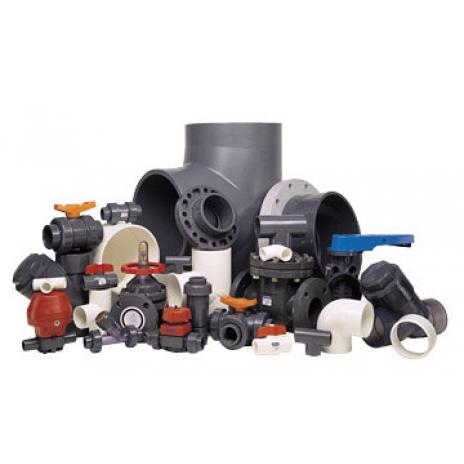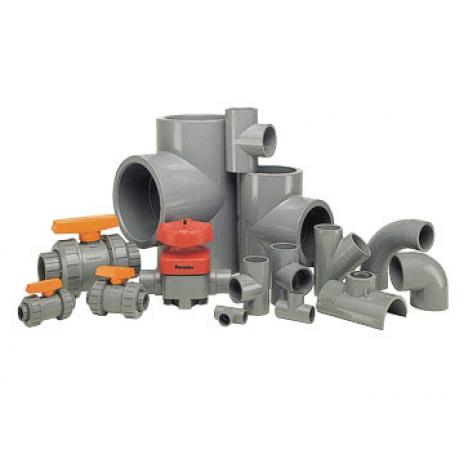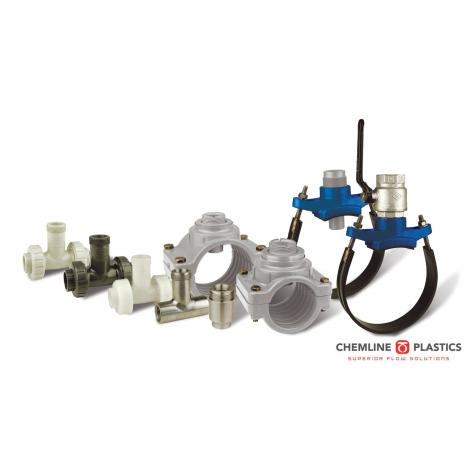- Toll Free 1.855.4RICE.RT
- Contact Us
-
Sign In
Thermoplastic Fittings
Rice offers a comprehensive range of integrated process piping systems designed to meet the temperature, pressure and size requirements of a wide range of chemical processing and industrial applications. Our leading line of fittings include PVC, CPVC, PVDF, HDPE, Teflon, and other more specialized materials in sizes up to 48” in diameter and virtually any configuration.
-
PVC & CPVC
Is the most frequently specified of all thermoplastic piping materials. PVC is characterized by distinctive physical properties and is resistant to corrosion and chemical attach by acids, alkalis, salt solutions and many other chemicals. It is attacked, however, by polar solvents such as ketones and aromatics. Of the various types and grades of PVC used in plastic piping, Type 1, Grade 1PVC (Cell Classification 12454) conforming to ASTM 1784, is the most common.
The maximum service temperature for PVC is 140°F under pressure and 180°F in drainage. With a design stress of 2,000 psi, PVC has the highest long-term hydrostatic strength (73°F) of any other major thermoplastic material used for piping. PVC piping is joined by solvent cementing, threading, flanging, grooving, gasket joints, or mechanical joints.
PVDF
Polyvinylidene Fluoride is a strong, abrasion-resistant thermoplastic with excellent heat stability and chemical resistance typical of fluorocarbon polymers. It can be used in temperatures up to 300°F with a wide variety of acids, bases and organic solvents, and is ideally suited for handling wet or dry chlorine, bromine and other halogens.
No other thermoplastic piping material can approach the combination of strength, chemical resistance and operating temperature that PVDF piping systems can offer. Electro fusion socket/butt/IR welding, threading, or flanged connections are the joining methods used for PVDF.
Polypropylene
Polypropylene is a lightweight polyolefin and generally high in chemical resistance. Although Type 1 PP conforming to ASTM D 2146 is slightly lower in physical properties than PVC, it is chemically resistant to organic solvents as well as acids and alkalis. Generally, PP should not be used in contact with strong oxidizing acids, chlorinated hydrocarbons and aromatics. PP has a design stress of 1,000 psi at 73°F, and has proven to be an excellent material for laboratory and industrial drainage pipe where mixtures of acid, bases and solvents are involved.
PP is joined by electro fusion process socket/butt/IR welding as well as mechanical joints.
HDPE
Pipe is lighter than traditional piping material, and results in substantial savings for handling and faster, less costly installation. Since HDPE is not brittle material, it can be installed with bends and over uneven terrain easily in continuous lengths without additional welds or couplings. Polyethylene pipe and fittings are well suited for use in slurry applications where its inherent toughness and abrasion resistance can be fully utilized.
HDPE pipe is very resilient and resistant to damage caused by external loads, vibrations, and from pressure surges such as water hammer. HPDE offers highly desirable properties that make it the preferred choice of pipeline material. The inherent properties of HDPE make it extremely resistant to the scale build up that leads to decreased flow rates and is impervious to most aggressive chemicals and corrosive elements. An added benefit is that HDPE fittings are more chemically resistant than stainless steel.
The exceptionally smooth inner surface offers minimal resistance to flow and the flow remains relatively constant for the life of the pipe, unlike other piping products that must allow for a reduction in flow capacity over time. When using HDPE, a higher maximum flow rate for a given size can be expected compared to other types of piping materials. Polyethylene butt, socket and sidewall fusion creates a joining system stronger than the pipe itself making a leak proof, fully restrained joint






